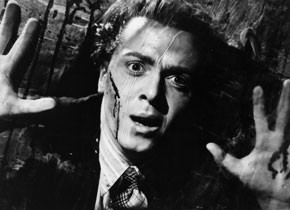Destination London
German-speaking Emigrés and British Cinema
May 8 to June 10, 2009
Filmmakers from the Continent had been working in British studios since the late silent era and were responsible for most of the outstanding works of those years, including E.A. Dupont's Moulin Rouge and Piccadilly, Arthur Robison’s The Informer, and Paul Czinner's The Woman He Scorned with Pola Negri. Since the German film industry was generally considered the model during the 20s and early 30s, these artists were much sought-after all over Europe. When the National Socialists seized power and with the subsequent mass expulsion of predominantly Jewish film artists, the number of émigrés to England soared. Overall, there were more than 400 primarily German-speaking Continental Europeans employed in all spheres of the British film industry in the 1930s and 40s.
Due to its (alleged) “non-Britishness”, which manifested itself in Continental themes, genres, camera and acting styles, this influx of talent was frequently greeted with reactions ranging from ironic skepticism to outright hostility (especially by local film workers who feared the loss of their jobs). In actuality, however, Great Britain was the country which profited the most from the diaspora of European film artists. The expertise and the technical-aesthetic know-how that the immigrants from the Continent had acquired in German and Austrian studios were incorporated in various ways into the ailing British film industry, and made a decisive contribution to the upswing and growth of British cinema.
In his pioneering essay from 1989, in which the parameters of film exile in Britain were examined for the first time, Kevin Gough-Yates points to this circumstance. “Taken as a whole, the influence these émigrés had on British film production was enormous. The Europeans had dominated British film production in the 1930s due to a number of interlacing historical features. The major writers, photographers, producers, and even directors of feature films in Britain throughout most of the 1930s were not British or, at least, were not British-born. When we consider the films of the 1930s, in which the Europeans played a lesser role, the list of important films is small.”
In 1934, the London correspondent for the émigré newspaper Pariser Tagblatt had already summed things up in an article entitled “German artists in English films”. “Is it really just by chance that the triumph of English films coincides with the decline of German cinema? A mere two years ago, English films were a local affair; they were not really taken seriously, they seldom made it out of provincial England, and only on rare occasions travelled as far as America. Yet today virtually every major English film has its New York première at the same time as the première in London, and many English films have scored huge successes and record profits in America. If one pursues the question of who the directors or stars of these films were, one comes across many familiar names.” In this context, “familiar” means, of course, well known in Berlin, Vienna, Prague and Budapest.
Alfred Junge's splendid Art Deco production designs; Mutz Greenbaum's black-and-white photography, reminiscent of Citizen Kane, in the forgotten masterpiece Thunder Rock (1942); Emeric Pressburger's recurring stories of alienation in his films with Michael Powell; Richard Tauber's moving portrayals of Franz Schubert and a Viennese Heurigensänger adrift in London in the films of Paul Ludwig Stein; Berthold Viertel's fantastic depiction of a child's destiny in the émigré production Little Friend (1934), based on Ernst Lothar's novel; the almost surrealist, thoroughly “composed” musical fantasy by Friedrich Fehér, The Robber Symphony; the participation of Central European filmmakers in almost all anti-Nazi productions; the inspired interventions of émigrés like Ernst H. Meyer (music) and Wolf Suschitzky (camera) in the British documentary movement; the groundbreaking work in early British television by the Viennese-born producer-director Rudolph Cartier – All these are just a few facets of the little-known, fascinating cosmos within film history which is now being arrayed for the first time in Destination London.
